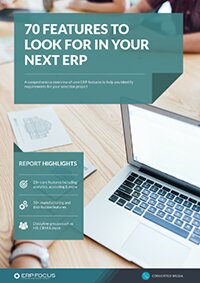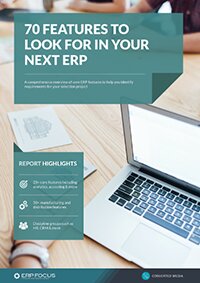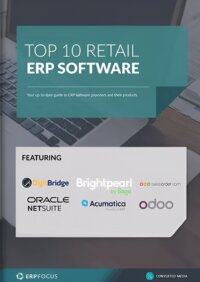How can ERP solve your omnichannel retail challenges?
As technology improves, and as customer expectations increase, retail evolves. This can be particularly seen when we consider the word “omnichannel”. Once dubbed a buzzword by marketers, omnichannel is now considered a way of life for today’s retailers.
Omnichannel means providing a smooth, seamless customer experience, no matter how they’ve heard about you. But with so many different platforms now available to consumers, supporting their various customer journeys can become tricky, cumbersome and time-consuming, especially the more your business grows.
This is where an ERP comes in to solve the challenges you may face and help you on your way to mastering omnichannel. Let’s discuss…
Find the right ERP for your business with our ERP Selection Survival Guide
1. Offer a seamless customer experience across channels
With built-in integrations and support for ecommerce platforms and marketplaces, ERP systems not only download orders into one central system for you, but they also update inventory levels and send shipping information to all your channels, ensuring your customers are kept informed.
2. Understand your customers’ buying habits
It’s important to establish which channels are most popular with your target audience and when consumers are browsing on those channels. With all customer data and information aggregated in a central ERP system, you can truly understand your customers’ buying habits and how they prefer to communicate with you and your brand.
3. Win at customer service
Imagine a customer places an order via your ecommerce website, and then phones up the next day as they want to make a couple of changes to it. If your staff are unable to locate the order based on a reference number or customer details, then that’s not only potential revenue lost from a good cross-sell or upsell opportunity, but you may also find yourself heading down the path of losing that customer’s repeat business. A centralized ERP, by its very nature, aims to solve this problem.
4. Speed up your time to ship
Most modern ERP systems will include a warehousing module or complete warehouse management system, enabling staff to scan goods in and out with a barcode, and perform inventory counts quickly. This simple act of being able to scan goods out of the warehouse will speed up your time to ship, not only quickly serving your customers’ needs, but also your own...
5. Reduce your processing costs
If it takes less time (and less people) to get products out of the door, your processing costs per order can be significantly reduced. This money can then be reinvested into the business to attract new customers, setup customer loyalty programs, expand your product range and whatever else you’d rather spend the money on!
6. Make better business decisions, faster
The best ERP systems have their own accounting and bookkeeping modules built-in, which means you can say goodbye to siloed systems and accounting data. You’ll gain real-time insight into your business’ performance, resulting in fast and better business decisions driving your strategy and how you can better respond to today’s omnichannel climate.
7. Eliminate siloed data
It’s not only siloed accounting data that you can say goodbye to. All your orders, inventory, purchasing, warehousing, CRM, point of sale and reporting data will also be contained within one centralized system. This ensures you have more efficient flows of cross-team communication, greater levels of transparency and accuracy across your entire operation, and the opportunity to better understand your customers and what it is they really want from your brand.
8. Stay in control of your inventory
To facilitate sales across all of your chosen channels, you may be operating from multiple locations, warehouses or storefronts, which introduces complexities. ERP systems ensure your inventory availability across channels is updated in real-time, ensuring your staff spend less time manually updating channels, and more time on customer service and sales.
9. Improve your business efficiency
With sales arising from multiple channels, and customers communicating with you in a variety of ways, improving your business efficiency is crucial for success. In general, ERP systems help to alleviate some strain placed on your business, such as automatically updating accounts, pulling up-to-the-minute reports and downloading orders in real-time. But there are some systems that take business efficiency one step further, by introducing a way for you to automate your entire end-to-end order process, such as automatically fulfilling or invoicing orders, or segmenting customers based on order history.
10. Improve your in-store experience
If you’re selling in brick and mortar stores or pop-up shops as well as online, then you’ll know all too well the challenges related to inefficient inventory counts, returns processing, and end of day processes. By integrating your point of sale with the rest of your back-office, ERP systems ensure your staff can focus fully on customer satisfaction and improving the in-store experience.
Final Thoughts
Today’s competitive retail climate conjures up many challenges, even more so when you throw omnichannel into the mix. But by implementing an efficient ERP, all of the challenges you face behind the scenes can become a thing of the past.
Free white paper

70 features to look for in your next ERP
A comprehensive guide to help you identify requirements for your ERP selection

Featured white papers
Related articles
-

Integrating your ERP with POS
How can integrating your ERP with your POS help to streamline your business?
-

Secret KPI: Why Your ERP Implementation Team Matters More Than Software
Learn how Godlan ensures successful ERP implementation for manufacturers with proven strategies &...
-

Requirements gathering for retail ERP
What are the most important factors of ERP requirements gathering for retail businesses?


